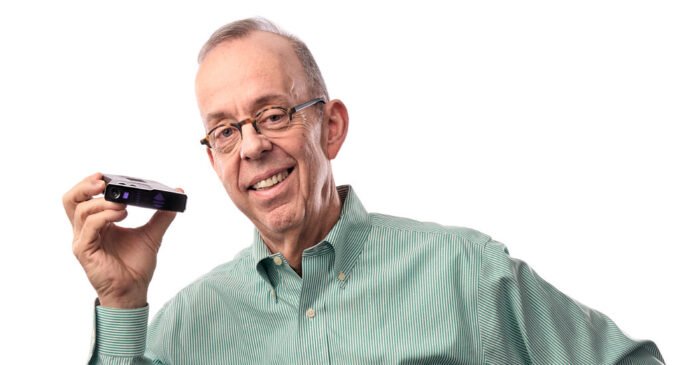Michael Valentine, an electrical engineer, loved to drive fast in his MGB sports car. But in 1974, after a national speed limit of 55 miles per hour was imposed as a fuel-saving measure, he believed a “holy war” had begun: speeding motorists against police officers trying to snare them with radar guns.
“In a holy war you can take either side and be right,” he told The Cincinnati Enquirer in 1981. He added: ‘The problem is that police radar is an electronic device that is fallible in the hands of ordinary people.’
Mr. Valentine, who did not believe that road safety was determined by finite speed limits, entered the battle armed with the Escort, a radar detector he built with Jim Jaeger, his college friend and business partner, for their company, Cincinnati Microwave. .
They enjoyed early success. In 1979, a year after the Escort’s debut, Car and Driver magazine tested twelve radar detectors and ranked this one as the best – “by a landslide” – for its ability to pick up signals from police radar equipment.
The rave catapulted sales. By early 1981, Mr. Valentine said Cincinnati Microwave had sold 50,000 escorts.
Mr. Valentine never stopped upgrading the Escort, and after parting ways with Mr. Jaeger in 1983, he designed two generations of detectors for his own company, Valentine Research.
After Mr. Valentine’s death on September 16 at the age of 74, Road & Track magazine lamented the loss of “one of the great saviors of speed.” The magazine added: “We are all indebted to Michael Valentine for his commitment to the automotive enthusiast community. And probably some of the money we saved on tickets too.”
Mr. Valentine’s wife, Margaret (Kreutzberg) Valentine, said he died of an aneurysm at his home in Cincinnati.
Michael David Valentine was born on October 28, 1949 in Dayton, Ohio, and raised in nearby Vandalia. His father, James, was a mechanical engineer; his mother, Lillian (McPhee) Valentine, oversaw the house. Mike’s father bought him a ham radio and he got his amateur radio license at age 14.
At the University of Cincinnati, where he earned a bachelor’s degree in electrical engineering in 1973, he met his future wife, who later became his partner at Valentine Research.
In addition to his wife, he is survived by his daughters, Martha Johnson and Anna Valentine; three grandchildren; and his sisters Kathy Valentine, Cheryl Valentine, Sandra Paulsel and Nancy Lowe.
One of Mr. Valentine’s first jobs was selling electronic components. He approached some radar detector manufacturers, including Electrolert, which made the popular Fuzzbuster radar detector, about purchasing a part that would allow their devices to actively search for radar signals instead of passively receiving them.
They all rejected him. Electrolert founder Dale Smith told him the part would make the Fuzzbuster too expensive and consumers wouldn’t buy it.
“He was completely unreceptive to it, and that’s very understandable” given how much money Mr. Smith made from the Fuzzbuster, Mr. Valentine told The Plain Dealer of Cleveland in 1983.
So Mr. Valentine and Mr. Jaeger built one themselves. Mr. Valentine’s Car and Driver obituary quoted Mr. Jaeger as recalling disassembling a Fuzzbuster and being “amazed at how primitive it was.” There was almost nothing in it. Mike and I started thinking about how we could build a superior, no-cost detector.”
He added: “We were a good team, with Mike very good at signal processing, while I was good at radio frequency technology.”
Mr. Valentine founded Cincinnati Microwave in 1976 with his father and Mr. Jaeger.
The first Escort sold steadily until the Car and Driver review, which called it “the best thing out there after buying a Judge.” The number of orders increased so quickly that there was a seven-month backlog in deliveries.
In 1983, a disagreement over marketing and a plan to go public, which Mr. Valentine opposed, led Mr. Jaeger to buy him out. While waiting for a five-year non-compete agreement to expire, Mr. Valentine and his wife founded Valentine Research.
Mr. Valentine eventually introduced the Valentine One radar detector in 1992.
“I had ideas,” he told Road & Track in 2020. “I wasn’t ready yet. It was like stepping off a speeding train. I looked at those passing by and wanted to move on.
Mr. Valentine has made numerous upgrades to the Valentine One over the past three decades, including one with antennas for radar signals coming from the front and rear and arrows that indicated the direction of incoming police radar signals. In 2020 he introduced a new detector: the V1 Gen 2.
Mr Valentine told Road & Track that he had tested several prototypes of the new device on the windscreen of his Porsche Panamera Turbo S E-Hybrid.
This year’s Car and Driver tests featured the second generation of Mr. Valentine ranks second overall, but at the top for detection distance. The review also called it the “talkiest” – the detector would beep if the setting wasn’t activated to eliminate the alerts – which the report said could be bothersome to some drivers, although it added that “others might find the peace of mind appreciate knowing that this thing won’t miss any radar.
Mr Valentine said he did not want to stop improving his detectors.
“I think I was exactly the guy to do this,” he told Road & Track in 2020, adding, “I don’t know how else to say it.”





